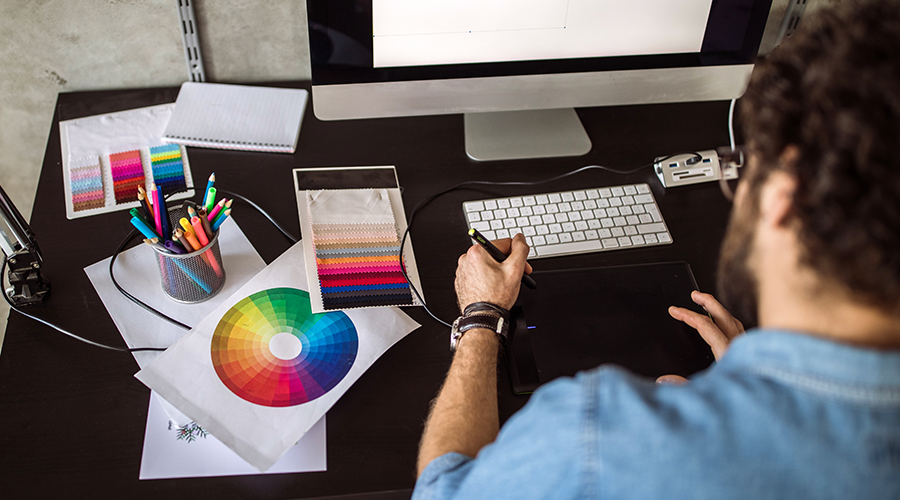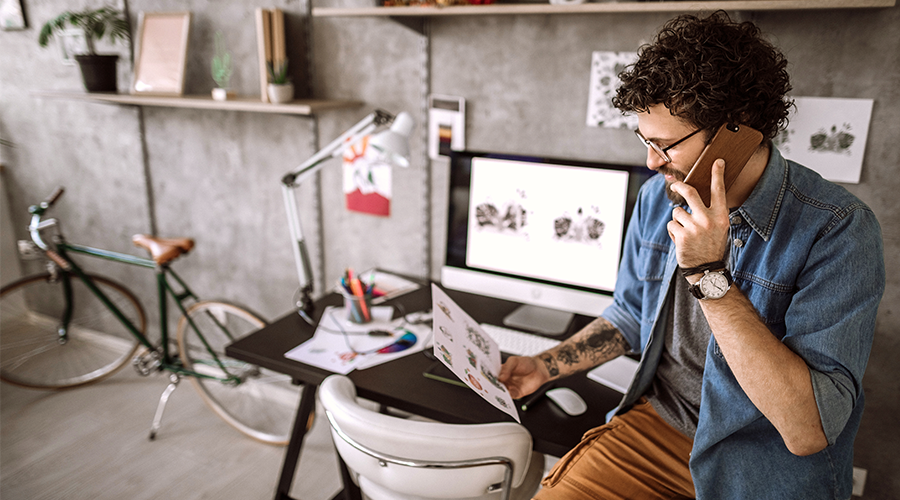Estimated reading time: 5 minutes

We chatted with Tristan LeBreton, Creative Director at 99designs by Vista, for his insights into how small business owners can better work with designers. Read on for Tristan’s tips on how to collaborate more effectively — and get great design for your small business.
When you’re running a small business, there’s going to be a lot of visual elements to your brand that you need brought to life. And whether that’s your logo or your website, it can be helpful to work with a designer. For many small business owners, the thought of turning over the visual direction of their brand to someone else — even a professional designer — can feel overwhelming. Fortunately, it doesn’t have.
“Seeing your brand come to life visually is immensely rewarding and fun, but it can also be daunting to put that task into the hands of someone else”, says Tristan. “Especially as a small business, you want every penny invested to be worth it.”
If you decide to work with a designer, there are a few things you can do to make it as positive an experience as possible. Here, get some tips from Tristan on effectively collaborating with a professional.
- Create a design brief.
- Set clear expectations.
- Be overly communicative.
- Invest in the revision process and stay open.
VistaPrint Tip
Before you can start working with a designer, you need to find one. With 99designs by Vista, you can browse hundreds of high-quality designers to find the perfect designer for your project — or host a design contest and review designs before you make a decision.
1. Create a design brief.
Designers aren’t mind readers. No matter how skilled and talented a designer may be, they’re not going to be able to bring your vision to life if they don’t have a clear understanding of that vision. “Before you start collaborating, it’s important that you map out what you need in a design”, advises Tristan. And the best way to do that is to create a design brief.
Design briefs are detailed documents that outline all the key details of your design project — and they’re a must when working with designers. “A thorough and well-thought-out brief gives a designer a launching-off point to build upon”, says Tristan.
Your design brief should include anything and everything your designer needs to successfully complete the project. “This includes both creative elements like your brand colours and visual style, and business elements like your target audience, industry and the purpose of the design”, Tristan adds.
Some elements you should consider adding to your design brief include:
- Your company slogan or tagline
- A description of your company and industry
- An explanation of your product and/or service
- A description of your target audience
- Your brand colours
- Examples of designs that have the look and feel you want to capture in your design
The more information and design direction you give your designer, the better they’ll be able to do their job — and the more likely you’ll be excited about the final product.

2. Set clear expectations.
You may have a clear idea of how you’d like to work with your designer and how you’d like your project to progress — but, if you don’t share that with your designer, it could lead to issues further down the road. “You want to give your designer as much creative liberty as possible, but if there are any non-negotiables that are important to be included, you need to let them know”, says Tristan. “To avoid any misunderstanding or unnecessary stress, align on expectations prior to the project and stick to them.”
One important expectation to set is around work styles. “Prior to starting a project, it’s a good idea to ask logistical questions such as ‘When is the best time to contact you?’, ‘How do you like to receive feedback?’ or ‘When can I expect to see a first draft?’”, continues Tristan. You’ll also want to get on the same page about how you’re going to communicate with your designer. For example, is email the best way to reach them on a day-to-day basis or do they prefer a text message? When you need to ask for revisions, should you type your requests into a document and send it their way via email — or is a video call more effective? Nailing down these details before you start working together will help save a lot of time and frustration throughout the design process.
“Given how important communication is in working together and achieving a shared vision, understanding each other’s work styles can make a big difference”, says Tristan.
You’ll also want to set clear expectations around the actual work. Agree on when the designer will deliver different elements of the project, what the revision process will look like and how often they’ll check in on their progress. “Designers are often working with multiple clients or projects, so it’s important that you have realistic expectations for revision requests, turnaround times, frequency of check-ins, deliverables and payment”, notes Tristan.
The clearer you and your designer are on expectations, the fewer opportunities there are for misunderstandings throughout the project — so make sure to set clear expectations from day one.
3. Be overly communicative.
Because a designer is a professional, you may assume that they know what you want from your design…but that’s an assumption you definitely don’t want to make. “One thing small business owners shouldn’t do when working with designers is assume they can read their minds”, says Tristan. “Saying you want ‘a design that stands out’ isn’t enough guidance.”
Designers can’t know what you’re thinking; if you want them to understand what you want from the design process, you have to tell them. And that’s why communication is so incredibly important. At the beginning of the project, don’t hold back any information. “The more detail you can offer your designer from the beginning, the better — as this will save any back and forth further down the line”, says Tristan.
Being overly communicative is also important when you’re delivering feedback on different iterations of the design. “When giving feedback, take the time to be as clear and specific as you can as to what you like and don’t like — and, more importantly, why you feel that way — so that designers can learn your preferences better”, says Tristan.

4. Invest in the revision process and stay open.
Most design projects will have at least a few rounds of revisions — and, if you want the final design to match up with your design vision, it’s important to invest in going through that revision process with your designer. “Design is a collaborative process, and it’s rare that even the best designer will produce something that is absolutely perfect straight away”, says Tristan. “So, if your designer turns up a design you don’t like at first, there’s no need to panic.”
When it’s time to request a revision, Tristan suggests taking the time to review each element of your design carefully so you can provide specific feedback on what you don’t like and why. For example, let’s say you own a restaurant — and you hired a designer to design a new menu. Instead of giving the feedback “I don’t like this design”, be more specific. Something like, “I really like the way you incorporated our logo onto each page. However, I think the font size for the actual menu items is too small and the colour is too light, which could make it hard for our guests to read. Can we make the text a bit bigger and darker?” is going to get you much closer to a design you’re happy with.
Now, during the revision process, it’s also important to remind yourself that you hired a designer because you’re not a design expert. So, while you should share insights into what you like and don’t like (and what you’d like to see change), you also want to stay open to hearing your designer’s insights about why they did things a certain way.
“Design is subjective”, says Tristan. “While as a small business owner you may not like a certain element of a design, like a particular font or colour, your designer likely chose it to serve a purpose related to your vision. So it’s best to have a conversation to better understand their thought process.”